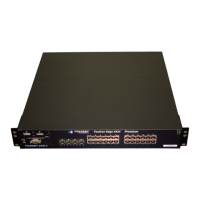Configuring OSPF
December 2005 © Foundry Networks, Inc. 20 - 21
When encryption of the passwords or authentication strings is enabled, they are encrypted in the CLI regardless of
the access level you are using. In the Web management interface, the passwords or authentication strings are
encrypted at the read-only access level but are visible at the read-write access level.
The encryption option can be omitted (the default) or can be one of the following.
• 0 – Disables encryption for the password or authentication string you specify with the command. The
password or string is shown as clear text in the running-config and the startup-config file. Use this option of
you do not want display of the password or string to be encrypted.
• 1 – Assumes that the password or authentication string you enter is the encrypted form, and decrypts the
value before using it.
NOTE: If you want the software to assume that the value you enter is the clear-text form, and to encrypt display
of that form, do not enter 0 or 1. Instead, omit the encryption option and allow the software to use the default
behavior.
If you specify encryption option 1, the software assumes that you are entering the encrypted form of the password
or authentication string. In this case, the software decrypts the password or string you enter before using the
value for authentication. If you accidentally enter option 1 followed by the clear-text version of the password or
string, authentication will fail because the value used by the software will not match the value you intended to use.
Changing the Reference Bandwidth for the Cost on OSPF Interfaces
Each interface on which OSPF is enabled has a cost associated with it. The Layer 3 Switch advertises its
interfaces and their costs to OSPF neighbors. For example, if an interface has an OSPF cost of ten, the Layer 3
Switch advertises the interface with a cost of ten to other OSPF routers.
By default, an interface’s OSPF cost is based on the port speed of the interface. The cost is calculated by dividing
the reference bandwidth by the port speed. The default reference bandwidth is 100 Mbps, which results in the
following default costs:
• 10 Mbps port – 10
• All other port speeds – 1
You can change the reference bandwidth, to change the costs calculated by the software.
The software uses the following formula to calculate the cost:
Cost = reference-bandwidth/interface-speed
If the resulting cost is less than 1, the software rounds the cost up to 1. The default reference bandwidth results in
the following costs:
• 10 Mbps port’s cost = 100/10 = 10
• 100 Mbps port’s cost = 100/100 = 1
• 1000 Mbps port’s cost = 100/1000 = 0.10, which is rounded up to 1
• 155 Mbps port’s cost = 100/155 = 0.65, which is rounded up to 1
• 622 Mbps port’s cost = 100/622 = 0.16, which is rounded up to 1
• 2488 Mbps port’s cost = 100/2488 = 0.04, which is rounded up to 1
The bandwidth for interfaces that consist of more than one physical port is calculated as follows:
• Trunk group – The combined bandwidth of all the ports.
• Virtual interface – The combined bandwidth of all the ports in the port-based VLAN that contains the virtual
interface.
The default reference bandwidth is 100 Mbps. You can change the reference bandwidth to a value from 1 –
4294967.

